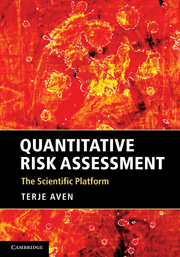Book contents
- Frontmatter
- Contents
- Preface
- Acknowledgments
- 1 Introduction to risk management and risk assessments. Challenges
- 2 Concepts and perspectives on risk
- 3 Science and scientific requirements
- 4 Introduction to case studies
- 5 Risk assessment when the objective is accurate risk estimation
- 6 Risk assessment when the objective is uncertainty descriptions
- 7 Risk management and communication issues
- 8 Towards a holistic scientific approach to risk assessment
- 9 Conclusions
- Appendix A Introduction to probability theory and statistical analysis
- Appendix B Terminology
- References
- Index
7 - Risk management and communication issues
Published online by Cambridge University Press: 05 June 2012
- Frontmatter
- Contents
- Preface
- Acknowledgments
- 1 Introduction to risk management and risk assessments. Challenges
- 2 Concepts and perspectives on risk
- 3 Science and scientific requirements
- 4 Introduction to case studies
- 5 Risk assessment when the objective is accurate risk estimation
- 6 Risk assessment when the objective is uncertainty descriptions
- 7 Risk management and communication issues
- 8 Towards a holistic scientific approach to risk assessment
- 9 Conclusions
- Appendix A Introduction to probability theory and statistical analysis
- Appendix B Terminology
- References
- Index
Summary
As stressed in Chapter 2, risk assessments provide decision support on the choice of measures and arrangements. Such decisions are risk-informed, not risk-based. There is always a need for seeing beyond the results of the risk assessments. There are two main reasons for this:
the limitations and boundaries of the risk assessments
the need for taking into account other concerns than risk when making such decisions.
The analysis in the two last chapters has addressed the first point, and in this chapter we will discuss the implications of the findings for risk management and communication where point 2 is a key issue. More specifically we focus on the following topics in this chapter:
the use of predefined risk criteria
the use of the ALARP principle and cost–benefit type of analyses
the role of the cautionary and precautionary principles
risk communication
the content and purpose of managerial review and judgement.
The use of predefined risk criteria
It is a common approach to risk management to use predefined risk criteria of the form “risk is unacceptable (intolerable) if P > p0”, where P is a risk-related probability index and p0 is a fixed number.
- Type
- Chapter
- Information
- Quantitative Risk AssessmentThe Scientific Platform, pp. 103 - 137Publisher: Cambridge University PressPrint publication year: 2011



